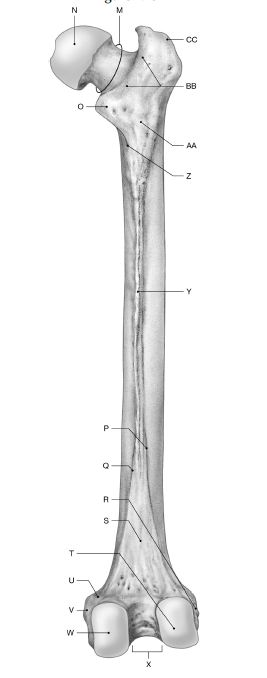Using the figure below, identify the labeled part.

1) Label M: ______________________________
2) Label N: ______________________________
3) Label O: ______________________________
4) Label P: ______________________________
5) Label Q: ______________________________
6) Label R: ______________________________
7) Label S: ______________________________
8) Label T: ______________________________
9) Label U: ______________________________
10) Label V: ______________________________
11) Label W: ______________________________
12) Label X: ______________________________
13) Label Y: ______________________________
14) Label Z: ______________________________
15) Label AA: ______________________________
16) Label BB: ______________________________
17) Label CC: ______________________________
1) Neck
2) Head
3) Lesser trochanter
4) Lateral supracondylar ridge
5) Medial supracondylar ridge
6) Lateral epicondyle
7) Popliteal surface
8) Lateral condyle
9) Adductor tubercle
10) Medial epicondyle
11) Medial condyle
12) Intercondylar fossa
13) Linea aspera
14) Pectineal line
15) Gluteal tuberosity
16) Intertrochanteric crest
17) Greater trochanter
You might also like to view...
The plasma membrane
a. has a slight excess of positive charges along its cytosol side during the resting state b. is composed primarily of cholesterol surrounded by carbohydrates c. is more permeable to K+ than to Na+ at the resting state d. has peripheral proteins that act as carriers e. exhibits all of the characteristics listed above
The _______ space seperates the dura mater from the arachnoid mater.
A. Epidural space B. Subarachnoid space C. Subdural space D. Dura space
The term apoptosis refers to.
A) the period from life to old age. B) degenerative changes associated with aging. C) wear and tear cellular damage. D) predetermined or programmed cell death.
You are looking at a cell with the electron microscope and you notice the following characteristics: presence of many mitochondria and lysosomes; few, if any, Golgi apparatus; and many ribosomes
Which of the following is the most likely function of that cell? A. DNA replication B. absorption of nutrients C. intracellular digestion D. modification of protein E. secretion of lipids